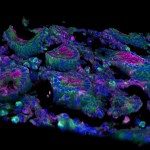Link to Pubmed [PMID] – 28762530
Link to DOI – 10.1002/eji.201747060
Eur J Immunol 2017 12; 47(12): 2113-2123
We and others have demonstrated that adipose tissue is a reservoir for HIV. Evaluation of the mechanisms responsible for viral persistence may lead to ways of reducing these reservoirs. Here, we evaluated the immune characteristics of adipose tissue in HIV-infected patients receiving antiretroviral therapy (ART) and in non-HIV-infected patients. We notably sought to determine whether adipose tissue’s intrinsic properties and/or HIV induced alteration of the tissue environment may favour viral persistence. ART-controlled HIV infection was associated with a difference in the CD4/CD8 T-cell ratio and an elevated proportion of Treg cells in subcutaneous adipose tissue. No changes in Th1, Th2 and Th17 cell proportions or activation markers expression on T cell (Ki-67, HLA-DR) could be detected, and the percentage of CD69-expressing resident memory CD4+ T cells was not affected. Overall, our results indicate that adipose-tissue-resident CD4+ T cells are not extensively activated during HIV infection. PD-1 was expressed by a high proportion of tissue-resident memory CD4+ T cells in both HIV-infected patients and non-HIV-infected patients. Our findings suggest that adipose tissue’s intrinsic immunomodulatory properties may limit immune activation and thus may strongly contribute to viral persistence.

